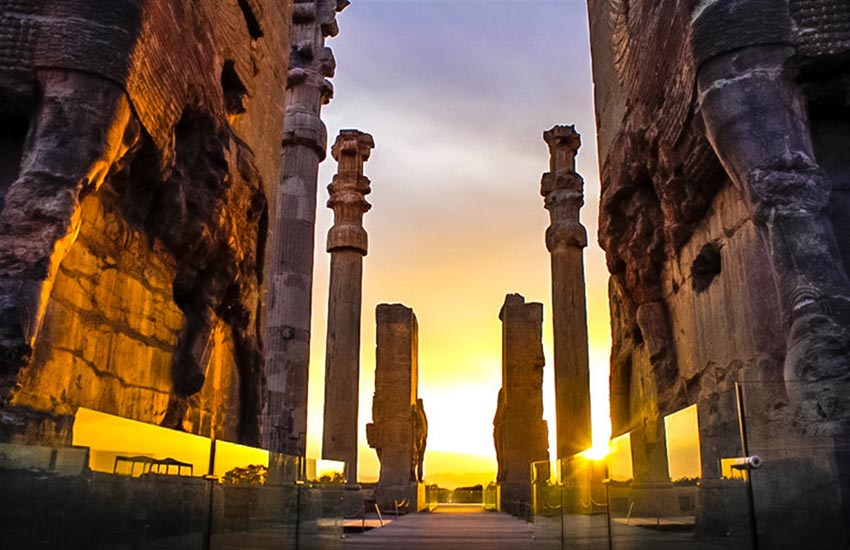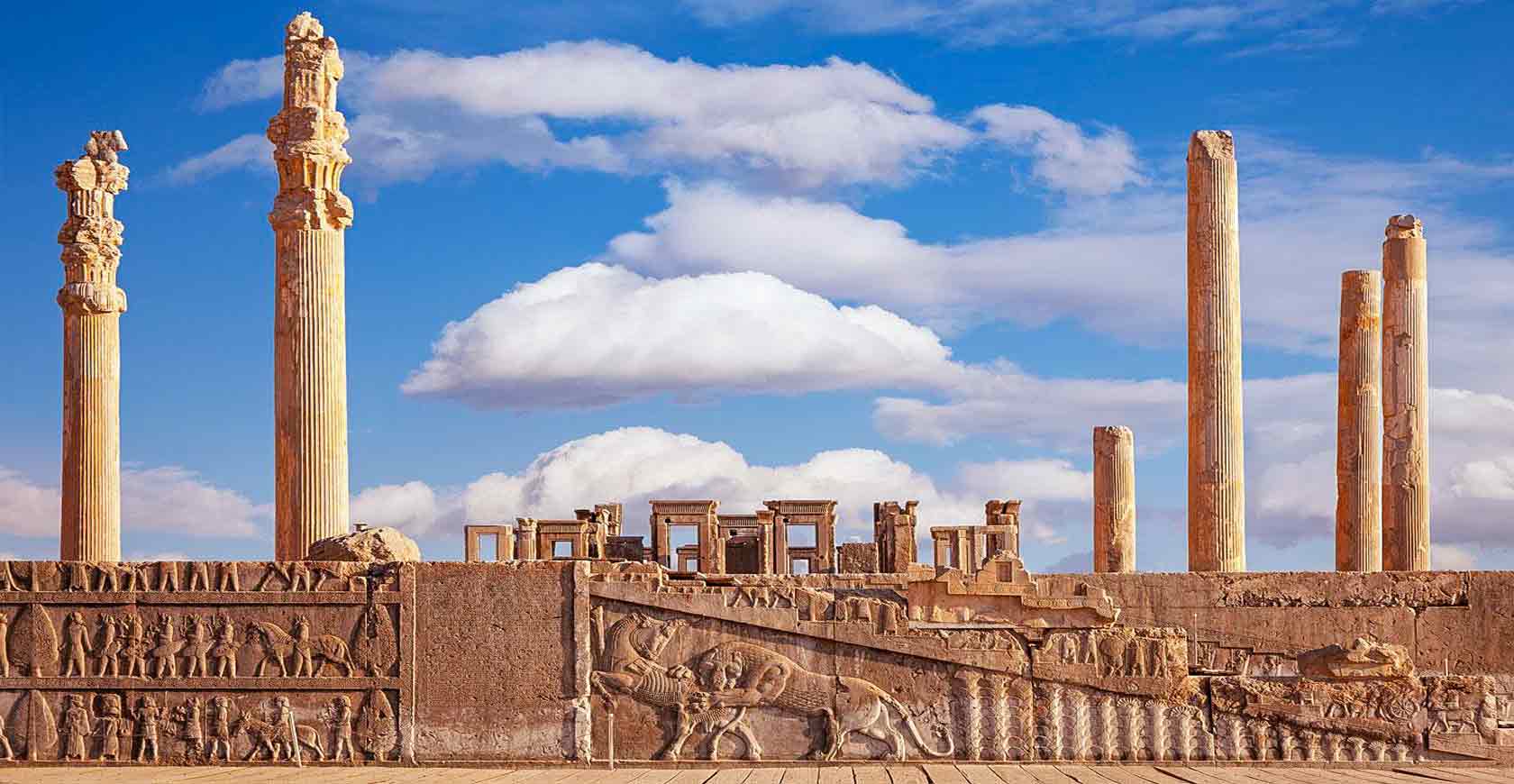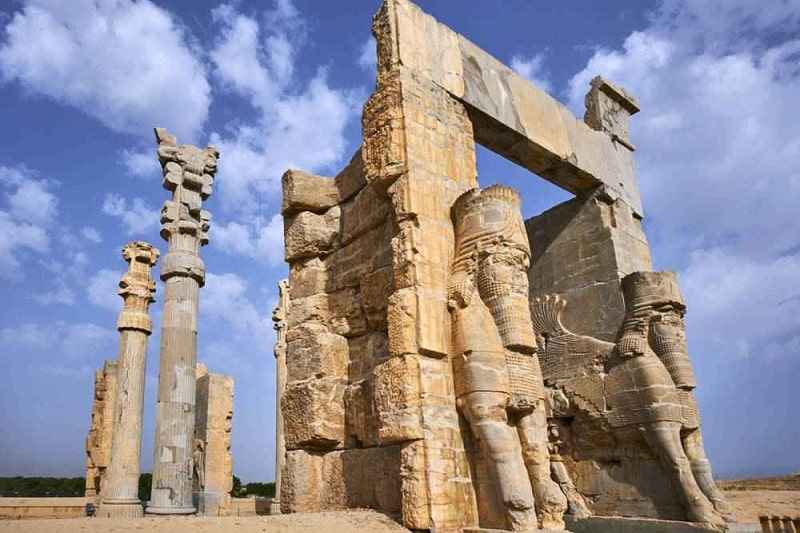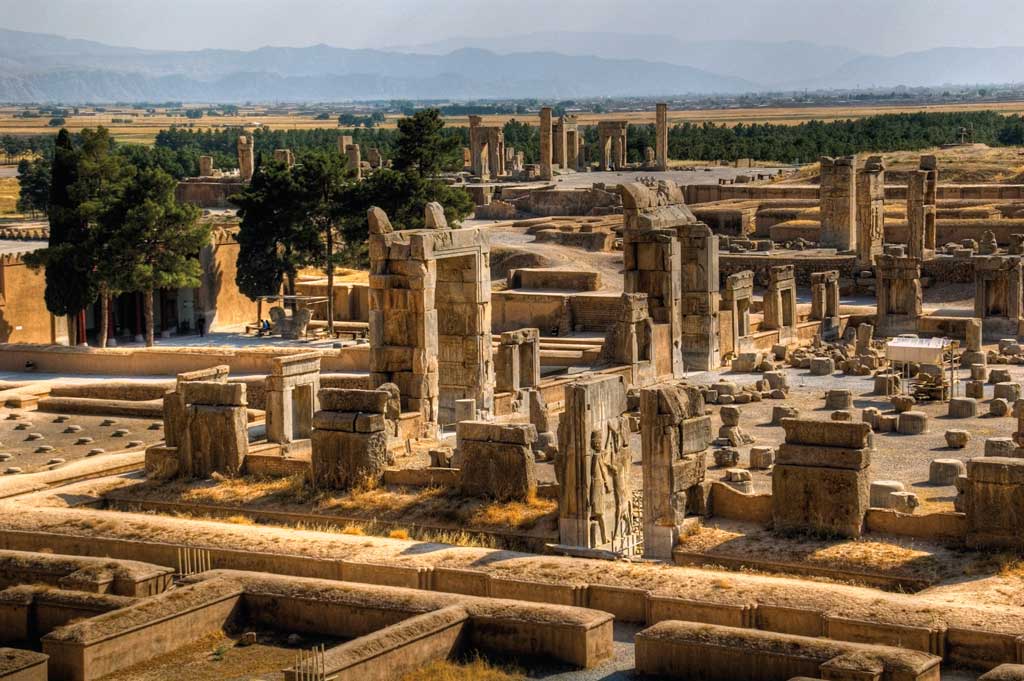Introduction to Persepolis
Persepolis as a symbol of Persian greatness, as well the center of the great Persian Empires and a display of Achaemenid art which means the place where the Persians live, who were led by the Achaemenids, besides Darius I’s purpose to build a capital in his empire is located on a slope called Mount Rahmat (“Mountain of Mercy”).
This huge building is one of the most important historical monuments in the world, which has been one of the three main capitals of the Achaemenids for several thousand years, but it has mostly ceremonial aspects and political work has been done in the two capitals of Susa and Hegmataneh.

History of Persepolis
Persepolis is founded by Darius I in 518 BC, but then his son Xerxes I the king and his grandson Artaxerxes I each added parts to the majesty of the masterpiece and architected the palace more magnificent than before. Persepolis was a royal spring / summer residence and Darius I planned this impressive complex of palaces, not only as the seat of government, but also as a peculiar exhibition and center for festivals.
Now then we have some information on the Achaemenid culture and history, we owe it all to the stone inscriptions of Persepolis. There are two identifying inscriptions from the Achaemenid era in Persepolis collection which are cuneiform and one of the most famous is for Darius I and his inscriptions, which have remained on the wall since the Sassanid era that demonstrates Persepolis as a palace with hundred columns at that time.
The Capital Architecture
Limestone and brick were the main building materials used in Persepolis, Achaemenid architecture is a mixed art adapted from Babylonian, Assyrian, Egyptian and Greek cites of Asia Minor, and released a creative and independent type of architecture with exquisite art and Persian spirit.
Persepolis consists of seven halls (palaces), stairs, columns (at that) me there were about 6 columns, some of which remain today) and two stone tombs, and main sections of Persepolis consist of dozens of small and large palaces and two pillars in the northern, southern and eastern portions, the northern and eastern porches being connected by stairs to the front yards, plus there are more than three thousand reliefs in the buildings and tombs that are remarkably harmonious with each other, among Persepolis palaces, the Apadana palace is more historical. Another surprise of Persepolis is that all the statues and engravings decorated in Persepolis are designed in different colors, for instance Darius I’s role in Thatcher Persepolis.

Destruction of the Ceremonial Capital
According to the historians, Alexander the Great set fire to Persepolis and left ashes from the books and arts available in the palace during the invasion of Persia in three hundred B.C.
Gate of all Nations in Persepolis
The Gate of Nations is one of the most beautiful palaces in Persepolis which was very crowded during the Achaemenid period. In fact, it was a small palace and at that time the representatives of the tribes had to enter first and then they could go to other palaces. The structure was planned to build during the reign of Darius the Great, but its building dates back to the reign of Xerxes I. This magnificent gate is world famous for its special appearance. Strange creatures with human heads, cows body and eagle wings is displayed on the gates which creatures are influenced by Assyrian and Babylon legends and show the greatness of the Achaemenid Empire.

Apadana Palace of Persepolis
Apadana Palace is one of the most beautiful palaces in Persepolis complex, where amazing and unique columns and stairs are still standing. Apadana Palace was built by order of Darius the Great in Persepolis to be used for Nowruz celebrations and to receive representatives of countries dependent on the presence of the king. The construction of this building was completed during the reign of Xerxes I king, 30 years after Darius the Great. The palace consists of 72 columns, of which only 14 remain.

Hadish Palace of Persepolis
Hadish Palace is located in the southernmost and highest part of Persepolis and it was the private palace of Xerxes l. The name Hadish is derived from an inscription On the north porch of this palace with this title: “Xerxes I king, the great king, says that I made this Hadish at the request of Ahuramazda…”. Hadish means a high place, but some believe that Hadish was the name of Xerxes’s wife, and that is why this palace is called Hadish. Unfortunately, the palace was badly damaged in the fire.
Treasury of Achaemenid Capital
The treasury is located in the southeastern part of Persepolis and was built by order of Darius the Great and during the reign of Xerxes I, some changes were made to it. Professor Schmidt, an archaeologist, found about 750 clay tablets in the building, each representing the unique wonders of the Achaemenid period, Inscriptions in Elamite script and language are engraved on about employers, workers, and how workers’ wages are paid.
Tomb of Artaxerxes II in the Capital Necropolis
The tombs of Artaxerxes II and Artaxerxes III of the Achaemenids are located on Rahmat Mountain and facing the Persepolis complex. The appearance of these tombs is in the form of a cross with four equal branches. The upper bouts indicative a religious or imperial religion. The Achaemenid king has a bow in this design and he is praying in front of the sacred fire. The king and the fireman are on the great throne of the kingdom and the representatives of the subordinate nations have kept this bed in their hands.
Light and Sound in Persepolis
The Glory of Achaemenid Kingdom at Night
Now that we have visited Persepolis in all its glory and splendor in the sun, walked around the its streets with the legendary animals, it is time to sit in place set for the live performances and wait for complete the darkness of the night to the guards of Persepolis hold the dances and carols of light and sound, to waken up Ardeshir II, to tell the narration of this magnificent breathtaking monument. The story of all the lotus flowers that adorn the walls of this huge collection. We are immersed into the deep dark sky when all of a sudden, we hear a sound that fills our whole being, a strong and powerful sound saying:
-Hear the night, the eternal peace in the silence, and the moon in the celebration of its two thousand in the glorious ruins of Persepolis, in the shadow of the peace and friendship and unity that Cyrus through and Darius estimate
– And indeed, we were strong enough…
And that’s the voice of Ardeshir, telling about the kingdom established by his ancestors, wit power and glory, the way he died, the black marble coffin in which he rests, and now we are about to take a walk though all the paths we passed under the sunlight to see the greatness of this Kingdom under the eternal moonlight, and to hear the story of the events of Persepolis nights. To walk with him with the guests from various satrapies enter the Gate of Nations with respect, who are greeted by Persian soldiers, presenting their gifts to the Achaemenid king, and enter the guest house to hear the story of all the bodies carved on the walls that each shows the faces of unique people.
As we see the dance of the lights on the body of this huge structure, Ardeshir tells about how his ancestors expanded the borders of this land from China to Egypt. All of a sudden, everywhere turns into red, and he tells the story of Alexander’s attack and the fire that destroyed this majesty.
In the end, the performance ends with the anthem “O Persia, O precious border” and what a more glorious ending that makes the greatness of a kingdom and such a collection memorable for us.

Location of Persepolis
Persepolis complex is located 10 km northeast of Marvdasht in Fars province in the foothills of Mehr Mountain. The distance from Persepolis to the magnificent city of Shiraz is more than 60 km.
Where to eat near Achaemenid Capital
Persepolis Persian Restaurant
Persepolis Persian Restaurant, is located on the private road of Persepolis. This restaurant is a complete traditional restaurant which include an interesting atmosphere and it is suitable for family gatherings.
Sufi Restaurant
Sufi Restaurant is one of the oldest restaurants in Shiraz, which serves a complete menu of Persian and French food in a lovely traditional atmosphere and it is decorated in the style of Zandieh era. Some say that the best Kalam Polo Shirazi (Cabbage and rice – a traditional food of Shiraz) is available in this restaurant.
Where to Stay near Persepolis
Parsian 4* Hotel
Parsian 4* Hotel is another member of Parsian Hotels Group, which is located in the center of the city with amenities and desirable services and is a good choice for tourists.
Darbary Hotel
The “Darbary Hotel” complex is located in the heart of the historical and cultural context of Shiraz. One of the important advantages of this 3* international hotel is the modern, up-to-dated facilities in the form of a traditional atmosphere.
Mah Monir Residence
Mah Monir Traditional Residence, the 120-year-old residence that dates back to the late Qajar and early Pahlavi eras, is considered as an economic hotel in Shiraz.
Persepolis Tourism Complex
Persepolis Tourism Complex is one of the hotels with a history of providing tourism services and in terms of geographical location is located at 8 km of Marvdasht-Persepolis road 72 km from Shiraz city.
Apadana Hotel
Apadana Hotel in Persepolis is a beautiful building belonging to the second Pahlavi era, which is located 100 meters from the magnificent Persepolis. This building is located in the middle of a garden that has provided a pleasant atmosphere for visitors.
Chamran Grand Hotel
Shiraz Chamran Hotel or Chamran Grand, a 5* luxury hotel in Shiraz, which is located in the highest point in the most pleasant climate of the cultural and historical capital of Persia, overlooking Qasr Al-Dasht, which gives you a unique view of Eram Garden and Hafez Tomb. Chamran Tourist Hotel complies with international quality standards, a variety of Persian, traditional and Italian restaurants, and a coffee shop with live music, creating pleasant memories of staying in a calm and pleasant environment.
Zandieh 5* Hotel
The five-star Zandieh Hotel in Shiraz is located in the Zandieh complex. This hotel is not far from the historical and cultural attractions of the city such as Karim Khan Zand complex and Pars Museum. The traditional Persian bath with impressive architecture is one of the most special services that the dear guests of this hotel can benefit from.
Aghamir Resort
Aghamir Ecological Resort in Pasargad, Shiraz, with a history of 100 years, is located in the historical context of Saadat Shahr. This residence is a native house with brick walls and a very beautiful and historical architecture belonging to many years ago and is also active in promoting cosmic tourism (Astro-tourism).
By staying at Aghamir Ecological Resort, in addition to experiencing a simple life in a native house, you can also benefit from the various programs of this accommodation. Pasargadae and the joyful local music are other important activities of this residence.
When to visit Persepolis
The best time to visit Shiraz in the spring is from March 10th to May 20th. Because in this season, the climate of Shiraz is in the mildest possible state and the orange blossoms of spring have beautified the city. Shiraz summers are very hot versus autumn which is a good time to visit Shiraz so you can plan a trip to Shiraz from early September to late December.
How to visit Persepolis
After crossing the big street of Persepolis, we reach one of the most famous Achaemenid capitals, Persepolis, with tall, lush trees. We calmly cross the 110 steps and reach the Gate of Nations with the ancient guards and ask for permission to enter. By passing through the glorious gates of the nations, we travel through history and enter a small palace which once the representatives of the subordinate countries were preparing to meet with the king. With these gifts from the Achaemenid states, we encounter different ethnic groups who go to the Apadana Palace to present gifts to the king.
We head to the Hundred Pillars Palace, the largest indoor hall in Persepolis, the gathering place of Achaemenid troops and warriors, and go to the Council Hall, where the king met with the elders of the country to consult with them.
The Mirror Hall is also famous and is an exhibition of inscriptions. Don’t forget the design of the cow and the lion on the entrance stairs and the Persian soldiers.
Then we go to Hadish Palace, Khashayar Shah Palace, which was built in the highest part of Persepolis.
In the end, we go to the Queen’s Palace, the current Persepolis Museum, to see the incredible objects inside and the headstone in front of the museum.
* Don’t forget comfortable backpacks and walking shoes, sunglasses, masked hats for sunny days and water bottles.
UNESCO world Heritage criteria of Persepolis
Criterion (i): Architecturally, the Persepolis complex with two-sided staircases, walls with carved images, gates, bulls, and the remains of the Hundred Columns Hall is a valuable collection. Achaemenid architects, with their amazing engineering, have used light and narrow columns to control the weight of the hall’s heavy ceiling. The diameter of these columns is 1.6 meters and their height is about 20 meters. On these pillars, there is the role of a double-headed cow holding the roof beam.
Criterion (iii): Extraordinary methods of engineering in buildings, stairs, administration hall, living room and other buildings, witness to the existence of an ancient civilization in this area that was unique in its time.
Criterion (vi): Perhaps, as Darius the Great himself was interested, Persepolis has become a picture of the glory of the Achaemenid rule, which shows the greatness and power of kings in different ways.
How to get to the Achaemenid Capital
One of the most exciting types of travel to Shiraz is traveling by car, which you can travel to Shiraz by passing through the historical and beautiful cities of Persia, as well as by bus. If you are eager to travel by train, you can travel to Shiraz by purchasing a ticket for a longer period of time. The fastest and easiest way to travel to Shiraz is by plane, which is a daily flight from Tehran to Shiraz International Airport (SYZ) called Shahid Dastgheib Flight.
To go to Persepolis, if you are going from Shiraz, first enter the city of Marvdasht and then go to Persepolis. The distance from Shiraz to Persepolis by car is about an hour.

